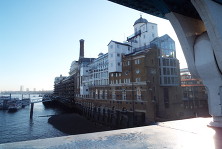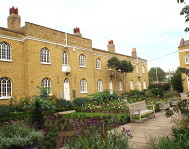








Girdlers Cottages
Girdlers Cottages are a row of very picturesque small houses, built in 1852 as almshouses by the Palyn Charity, but now owned privately. George Palyn, like Cuthbert Beeston whose bequest at the end of the 16th century was responsible for the building of Beeston’s Gift Almshouses in Consort Road, was a Master of the Girdlers Company who died in 1609. His will directed that the Girdlers’ Company was to receive £900.
£260 of this sum was to be used within two years of his death in building a hospital or an almshouse in or near the City of London for the “perpetual relief and sustentation of six poor men” who were to be of honest repute and freemen of London. The almshouse or hospital was to contain at least six rooms to provide a home for six aged, blind or impotent men. The balance of £640 was to be used to purchase land and property that would bring an income towards the maintenance of the almsmen.
Six separate almshouses were built in Old Street and the Girdlers Company provided at their own expense a bible and service book in large print together with a desk to rest them on for the use of the almsmen. These first almshouses were destroyed in the Great Fire of London in 1666, as were the properties that had been bought in Sherborne and Abchurch Lanes to raise money for pensions for the almsmen. The almshouses were rebuilt in Pest House Row, so-called after a building where plaque victims were consigned and later renamed Bath Street. The almshouses were rebuilt in 1745 but in 1849 it was reported they had become too dilapidated to repair. One of the Girdlers Company’s members, Thomas Watkins, donated a piece of land in Peckham and new almshouses were built in Choumert Road and, on the day the pensioners moved into the new almshouses, paid for them to have what is reported “a very good meal.” The vacated land in Bath Street was let on a building lease which increased revenue for the charity, a part of which was now also given in support of other hospitals and institutions for the relief of the poor in London.
Residents of both Palyn’s and Beeston’s Almshouses were governed by a set of rules which, if infringed, could be punished by expulsion though the Company were reluctant to take such action. Recorded offences carried out by the Pensioners include “reviling and quarrelling of wives about drying of clothes,” “neglecting prayers” and “swearing and other incivilities” but mostly expulsion was avoided. The dwellings in Choumert Road each had an individual garden but the Company paid for a gardener to keep the gardens at the front bright and tidy, both here and at Beeston’s Almshouses, and to do the heavy work once a week.
…
By the 1980s, the Beeston’s Charity and Palyn’s Charity had merged together with other charities that came under the Girdlers Company administration. The residents from Choumert Road moved to an enlarged Beeston’s Almshouses in Consort Road which now provides accommodation for 24 residents in a total of 17 units.